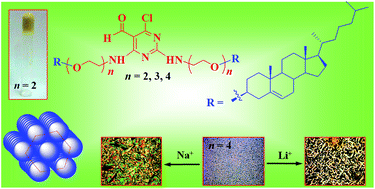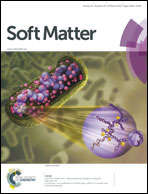Differential response of cholesterol based pyrimidine systems with oxyethylene type spacers to gelation and mesogen formation in the presence of alkali metal ions†
Abstract
A new series of lipophilic cholesteryl derivatives of 2,4,6-trichloro-pyrimidine-5-carbaldehyde has been synthesized. Oxyethylene spacers of variable lengths were inserted between the hydrogen bonding promoting pyrimidine core and the cholesteryl tail in order to understand their effect on the self-assembly of these compounds. Only compound 1a with the shortest spacer formed a gel in organic solvents such as n-butanol and n-dodecane. While other members (1b and c) having longer spacers led to sol formation and precipitation in n-butanol and n-dodecane respectively. The self-assembly phenomena associated with the gelation process were investigated using temperature-dependent UV-Vis and CD-spectroscopy. The morphological features of the freeze-dried gels obtained from different organic solvents were examined by scanning electron microscopy (SEM) and atomic force microscopy (AFM). The solid phase behaviours of these molecules and their associated alkali metal ion complexes were explored using polarized optical microscopy (POM) and differential scanning calorimetry (DSC). The molecular arrangements in the xerogel and in the solid state were further probed using a wide-angle X-ray diffraction (WAXD) technique. Analysis of the wide-angle X-ray diffraction data reveals that this class of molecules adopts a hexagonal columnar organization in the gel and in the solid state. Each slice of these hexagonal columnar structures is composed of a dimeric molecular-assembly as a building block. Significant changes in the conformation of the oxyethylene chains could be triggered via the coordination of selected alkali metal ions. This led to the production of interesting metal ion promoted mesogenic behaviour.


 Please wait while we load your content...
Please wait while we load your content...